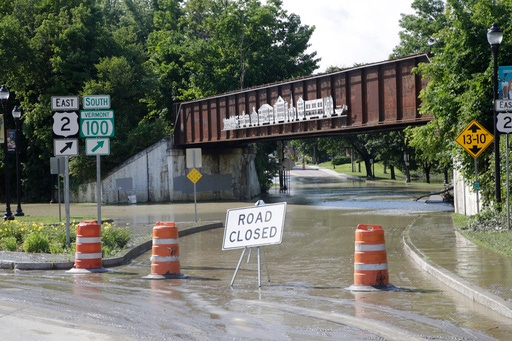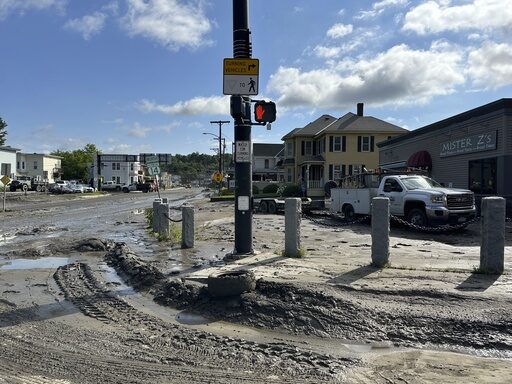Vermonters, pummeled by floods exactly a year apart, are assessing damage, beginning cleanup

Water floods a street, Thursday, July 11, 2024, in Waterbury, Vt. (AP Photo/Hasan Jamali)[ASSOCIATED PRESS/Hasan Jamali]
PLAINFIELD, Vt. (AP) — Volunteers, some with heavy equipment, shoveled river silt and mud from roads, homes, yards and driveways and removed flood-ravaged items from homes Friday in one of the Vermont communities hardest hit by flooding from the remnants of Hurricane Beryl.
Former students of a now retired school principal, whose home and yard were among those damaged, showed up to help.
“I think as a community we all got to come together and give a hand and receive nothing but just giving the love back that he’s given the community and to the school,” said Dillon Mears, 33, of Owen Bradley. Some wore t-shirts emblazoned with the word “love,” a message that Bradley and his wife Jane spread.
The couple’s son flew in Friday morning on a red eye from Oakland, California, and quickly went to work with others.
“This is how we are. You know, there’s people over there helping out, as soon as we’re done here, we’re going to help everybody else out,” said Adrian Bradley, 35. “That’s Vermont. It’s a small state, 600,000 people, we know everybody, you help your neighbors.”
Gov. Phil Scott said Friday it’ll take several more days to fully assess damage from flooding caused by the remnants of Hurricane Beryl, but he said Vermont is better positioned to recover quickly after enduring heartbreak, federal red tape and an extensive cleanup from massive floods exactly a year ago.
“We can all use what we learned last year to quickly strengthen our response, and that starts with getting homes, businesses and communities clean and dry as quickly as possible,” Scott told reporters at a briefing in Berlin.
He praised the resilience of Vermonters who are accustomed to making do without government help in rural areas, but also urged them to take time to report damage and not to be afraid to ask for assistance.
Beryl’s remnants dumped more than 6 inches (15 centimeters) of rain in just a few hours Wednesday and Thursday on parts of Vermont, destroying and damaging homes, knocking out bridges, cutting off towns and retraumatizing a state where some people are still awaiting assistance from the last catastrophic floods that hit a year ago to the day.
Two people — a motorist in Lyndonville and a man riding an all-terrain-vehicle in Peacham — were killed by the floodwaters, authorities said.
The Vermont Department of Transportation is releasing nearly $30 million in town highway payments by early August — half of it by next week — to help communities repair washed out roads, bridges and culverts, said Joe Flynn, secretary of transportation. The state has already reopened all but 18 of the 54 state roads that were closed by flooding or storm debris, he said.
Public Safety Commissioner Jennifer Morrison urged people on Thursday to take advantage of sunny weather forecast for the next few days to get as much cleanup done as possible, moving sodden rugs and furniture to dry outside to reduce the likelihood of mold.
And speaking to Vermonters not directly affected, she urged them to volunteer through state programs or to “simply roll up your sleeves, grab a shovel, and help your neighbors.”
Elsewhere in Plainfield, a concrete bridge that collapsed and tumbled downstream was likely responsible for ripping off part of an apartment building with five units, said Michael Billingsley, the town’s emergency management director.
The occupant of another home was pulled through a window to safety moments before it was swept downstream, and a mobile home floated away with four pets belonging to a family that narrowly escaped, he said.
Similar stories played out across Vermont, where state swift-water teams alone rescued about 120 residents. Many more were rescued by local emergency responders, officials said.
Beryl, blamed for at least nine U.S. deaths and 11 in the Caribbean, made landfall nearly 2,000 miles (3,220 kilometers) away in Texas on Monday as a Category 1 hurricane that left millions in the Houston area without power. But it wasn’t done. The storm traveled across the interior U.S. as a post-tropical cyclone that brought flooding and some tornadoes from the Great Lakes to northern New England and Canada.
The storm spawned seven tornadoes that hit western New York on Wednesday, the National Weather Service said. Flash flooding also closed roads in several northern New Hampshire and upstate New York communities.
Even though Vermont is not a coastal state, it has been pummeled before by tropical weather systems. Tropical Storm Irene dumped 11 inches (28 centimeters) of rain on parts of Vermont in 24 hours in 2011. The storm killed six in the state, washed homes off their foundations and damaged or destroyed more than 200 bridges and 500 miles (800 kilometers) of highway.
Vermont officials on Friday said the state updated requirements for culverts and bridges after Irene to account for the likelihood of more dangerous storms due to climate change, and none of the bridges that washed out in the latest flooding were those rebuilt to the higher standards.
In May, Vermont became the first state to enact a law requiring fossil fuel companies to pay a share of the damage caused by extreme weather fanned by climate change. But officials acknowledged Friday that collecting any money will depend on litigation against a much-better-resourced oil industry.
___
Associated Press writers David Sharp in Maine, Holly Ramer in New Hampshire, Seth Borenstein in Washington and Stefanie Dazio in Los Angeles contributed to this report.
Copyright 2024 The Associated Press. All rights reserved. This material may not be published, broadcast, rewritten or redistributed without permission.
